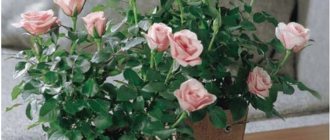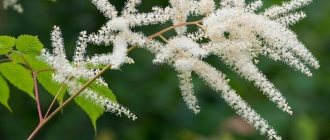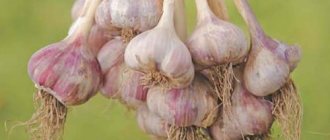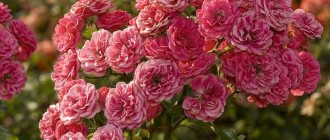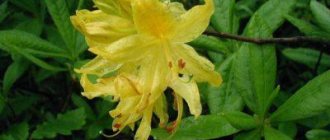The herbaceous perennial plant Maryin root (Paeonia anomala), also called extraordinary peony, or Maryin root peony, or evasive peony, or irregular peony, is a species included in the genus Peony. Most often, this plant is found in Siberia, and it prefers to grow in meadows, river valleys, on the edges and clearings of mixed forests. This species is listed as endangered and is included in the Red Book of the Komi Republic. In the name of the species, the word “anomala”, translated as “unusual” or “irregular”, appeared due to the fact that in autumn this plant differs from other representatives of the Peony genus in its color. This species has been cultivated since 1788. Gardeners grow this peony as a medicinal and ornamental plant. As a medicinal plant, the name of this genus, marin root, is most famous.
Description: varieties and varieties
There are quite a lot of varieties and varieties of peony.
It comes in the form of a herbaceous plant and shrub. It is also found in the form of a subshrub. In nature, on the territory of our country, marin root can be found in some places of the wooded strip of European territory and in Siberia. It settles on taiga edges in forests, meadows and along floodplains, in mountainous areas. For a long time, this type of peony has been used to decorate gardens. In the photo you can see how great it looks, especially in bloom. Maryin root is excellent for open ground, withstands even the harshest winters, and is very easy to grow and propagate.
Maryin root - a type of peony
When grown in garden plots, this peony variety reaches a height of 1 m. Under favorable conditions, it can sometimes be larger in size. It grows as a bush with several erect branches. Each branch has several complex and large-sized leaves, which reach a length and width of about 30 cm. It blooms profusely, for about two weeks. Flowering time occurs from late spring to June. The flowers are large, about 15 cm in diameter, sometimes larger. The color is crimson or pink-purple. The root system of the plant is well developed.
Spreading
The marin root flower prefers to settle on the edges of deciduous or dark coniferous forests. It grows in the center and south of Eurasia in China, Mongolia, and Kazakhstan. In Russia, it is distributed in Siberia, the Perm and Murmansk regions, in the valleys of the Pechora River and in Altai. Found in mountains up to the subalpine zone. The soil needs to be moist and rich in minerals.
Planting a plant
To plant this unpretentious plant, choose an open and well-lit place. Maryin root tolerates some shading well. But in the shade the plant feels worse and eventually stops blooming. To place bushes in open ground, it is advisable to choose a place away from buildings, since there is less air circulation near walls. But when planting this plant, you should avoid areas where there are drafts, which the marina root does not tolerate very well.
Attention! Planting peony evasive in open ground is carried out in the fall before the onset of frost or at the very end of summer. At this time, the plant takes root best. Transplantation of the marina root for its propagation is carried out during the same period.
To plant this variety, select an area with light, loose, fertile soil, where water does not stagnate. From excess moisture, the rhizome of the plant begins to rot, and from this the evading peony may simply die. Therefore, places with high groundwater should be avoided.
Protect marin root from excess moisture and stagnation of water.
Planting holes measuring approximately 60 by 60 cm are prepared in advance, filling them with good garden soil in combination with peat and humus. You can also add ash there. When the soil settles, you can plant the plants. When planting several peonies, the distance between the seedlings should be at least 1 m to leave room for the bushes to grow.
Advice. It is better not to plant the rhizome of Maryina root in the ground deeper than 5 cm from the ground. When planted deeper, the peony blooms much worse.
Growing from seeds
Under natural conditions, the extraordinary peony reproduces by self-seeding (except for places where the seeds do not have time to ripen). Shoots may appear in the spring or delay for 1-2 years. Growing a flower from seeds at home will require a lot of time and patience. You can't count on flowering soon. Poor seed germination is due to the durable shell. To activate growth, stratification is used - alternating exposure to heat and cold.
Advice. Start collecting seeds before they are fully ripe, but not earlier than mid-August. Their shell is softer and lighter.
The seeds of the evasive peony are brown, smooth and elastic. Size 0.5-1 cm. They are sown immediately after collection in open ground or prepared containers with substrate. In nature, seeds undergo a natural process of stratification; at home, it is created artificially. In the first year after wintering, plants take root. Leaves and shoots will appear only after a year. During the cold period, the beds with seeds are mulched with straw and dry leaves. In cold regions, they are additionally covered with spruce branches.
Maryin root: care features
Caring for this plant in open ground conditions cannot be called too difficult. But some features when growing marina root are still worth paying attention to. When caring for it you will need:
- carry out regular watering, but do it quite moderately;
- apply fertilizers and do foliar feeding;
- prune the plant;
- loosen the soil and remove weeds.
An important component of care is watering the plants. You need to water the marina root in sufficient volume, but not in excess, so that there is no stagnation of water in the ground. And it is better to do this not at the root of the plant, but to build furrows around the bush for watering. It will also be possible to put the necessary fertilizers in them.
Peony needs pruning in autumn
Peony care also consists of loosening the soil after rains so that it is breathable and without crust on the surface. All weeds must be removed promptly. In autumn, the bushes are pruned short. Adult plants do not require shelter. The land around young seedlings can be mulched.
Use in medicine
Maryin root is valued not only for its decorative appearance, but also for its medicinal properties. The root part of the plant is mainly used. but the above-ground part is also used.
The composition contains flavonoids, alkaloids, saponins, essential oils, ascorbic acid, as well as useful elements: magnesium, iron, calcium. Decoctions are prepared from marina root.
It is used in the treatment of the following diseases:
- Gout;
- Hypertension;
- Diseases of the gastrointestinal tract;
- Rheumatism;
- Radiculitis;
- Stomatitis;
- Diseases of the nervous system, stress, depression;
- Sleep disturbance;
- Infertility;
- Uterine bleeding;
- Mastopathy;
- Urinary tract problems;
- Asthma.
Marin root is also used to increase immunity, promote good appetite, improve digestion and metabolism. Removes toxins in case of poisoning. Treats cough, flu, colds, skin diseases. Has an analgesic effect.
Fertilizers and fertilizing
When growing evasive peony, two types of fertilizing are used:
- foliar;
- root.
For foliar feeding, liquid mineral fertilizer is used, which is diluted in water according to the instructions. This method is used to spray the leaves of the plant about three times per season.
Advice. Foliar feeding of leaves is best done on a cloudy day.
It is also necessary to fertilize the roots about three times during the growing season. For the first time, they are fed in the spring until the snow cover completely melts using nitrogen fertilizers, which are scattered on the surface. Next, they are fertilized at the beginning of flowering and after it ends, closer to autumn, with a complete mineral fertilizer with a predominant content of phosphorus and potassium. You can also take mullein infusion for the second feeding.
Diseases and ways to combat them
Peony has good immunity to various diseases. The only problem that gardeners may encounter is gray rot, which occurs due to improper watering.
Preventive measures will help avoid this problem. To do this, pour a fungicidal solution under the bush of each plant. Repeat three times with an interval of two weeks.
Dangerous pests that can be found on a flower are:
- bronze;
- aphid;
- ants.
You can get rid of them with the help of insecticides and folk remedies. Use in accordance with the instructions, otherwise you can harm the physiological process of plants.
Plant propagation
Maryin root propagates quite easily. There are three ways to reproduce it:
- seminal;
- cuttings;
- dividing the bush.
It is more convenient to propagate marin root by dividing the bush.
All these methods are quite successfully used by gardeners. But when propagated by seeds or cuttings, the peony will bloom only after a few years. Therefore, dividing the bush is more often used. An adult strong plant needs to be trimmed, carefully removed from the soil with a lump of earth, the rhizome washed with water and carefully divided into parts with a sharp knife so that each has several buds. Before planting in the ground, the separated parts of the rhizome must first be disinfected in a solution of potassium permanganate. Then it is better to treat them with a stimulant, for example, Kornevin.
Instructions on how to grow peony from seeds at home
The collected seeds are soaked overnight in water with the addition of the growth stimulant “Epin”, “Heteroauxin”. Stratification is performed according to one of two schemes:
- Warm-cold-warm.
- Cold-warm-cold.
The first option is more effective, let's focus on it.
First phase (warm):
- Fertile soil (2 cm) and sand (2 cm) are poured into a wide container. Well moisturizes.
- The soaked seeds are laid out on the surface and covered with a 1 cm layer of sand.
- The container is covered with glass or film and placed in a warm place with a temperature of 28-30°C during the day and 15°C at night. This temperature regime is maintained for 2 months. Heating radiators, an electric heating pad and directional lamp light will help provide heating. The soil is moistened with a spray bottle and ventilated once a week. By the end of the first warm phase, white roots appear.
Second phase (cold):
- It is necessary to pinch the tip of the spine (carefully!).
- A separate pot or glass is prepared for each plant; you can buy peat tablets. Universal soil for flowers is poured into each container and a sprouted seed is placed.
- The pots are covered with film to retain moisture and transferred to a room with a temperature of 6-10°C.
- This period takes 3-4 months. The soil is periodically moistened and ventilated. As a result, the first leaf appears.
- Attention. Treatment of cotyledons with a solution of gibberellic acid (growth hormone) accelerates the appearance of leaves.
Third phase (warm):
- The seedlings are transferred to a warm room with a temperature of 18-23°C. Keep under cover, moisturize, and ventilate.
- The third stage has a different duration; seedlings can be planted in the spring or wait until August. The second option is preferable; by the end of summer the sprouts will get stronger.
Advice. Purchased seeds are drier due to long storage. Soak them for 2-3 days. Before planting, you can lightly rub the shell with sandpaper or sand.
While the seedlings are waiting to be planted in open ground, they need to be looked after. In addition to moisturizing, treatment with a fungicide will be required. The procedure will eliminate infection with rot and other diseases. For peonies, choose a bright place with slight shading, away from lowlands and groundwater. The area must be protected from the wind. When planting, care should be taken not to damage the thin roots. They operate using the transshipment method, removing the seedlings along with a lump of earth.
After filling the hole, watering is carried out. The surface is mulched with straw. Before frost, the young plant will have time to take root in its new location. In spring the buds will begin to grow. The first flowers will appear no earlier than after 4 years.
Combination of evasive peony with other plants
Maryin root looks great both in single and mixed plantings in combination with other decorative foliage and flowering plants. The foliage of this peony is also decorative. It looks very beautiful both in spring and summer, and in autumn. Various uses of peony evasive in landscape design can be seen in the photo. It is often planted in the garden near fruit trees.
This unpretentious plant takes root well in garden plots. It is perennial and does not require annual replanting. Even with minimal care, the marin root will delight the gardener with its beautiful lush flowering.
Peonies after flowering
The bush can be replanted only after the flowering period has ended. If the flower does not look sick and there is no urgent need to move it to a new place, then it is better to postpone the event until September.
Transfer
It is not recommended to do a transplant more than once every 3 years, and only if truly necessary. In this case, the roots must be divided and buried no more than 5 cm when planting.
Trimming
The plant pruning procedure is carried out in the fall, shortly before the onset of winter cold. Leaves and stems are completely cut off from the bush to a height of 10 cm, composted or burned.
Preparing for winter
In young plants, the above-ground parts remaining after pruning are sprinkled with ash and covered with spruce branches. Mature shrubs of evasive peony do not need winter shelter.
Description of the species
The evasive peony belongs to the only species of its kind in the Peony family, which unites more than forty varieties of perennials. You can meet them in the subtropics of Asia and the Mediterranean. In Russia, 15 plant species are described - endemic to the Caucasus and Crimea.
Peony evasive is a powerful perennial up to 1 m in height with a short branched root of brown or brown color. The adventitious roots are fleshy and shaped like a spindle.
The stems are mostly straight, with ribbed edges, leafy and single-flowered. The top is covered with hard scales. Large (up to 30 cm in length and 2.5 cm in width) petiolate leaves are arranged alternately. The leaf is complex: with pinnately dissected leaves and lanceolate lobes.
The flowers are also large (up to 13 cm in diameter), terminal, with a double perianth. The calyx is five-leaved, the leaves remain with the fruit. The corolla is also five-leaved, pink in color with numerous stamens and one or two pistils.
The formula of the plant evasive peony is O∞ T∞ P5-2. The fruit is a multi-seeded, three- to five-leafed plant with black, shiny, oval-shaped seeds. The active flowering period is May-June, fruits appear in the next two months.
Chemical composition
The plant has not been fully studied, but the main components are known. The composition of marina root includes the following substances:
- Fatty oil.
This component is necessary for hematopoiesis, strengthening the body's defenses, restoring normal hormonal levels and the biochemical composition of the blood. The substance also helps eliminate bad cholesterol. - Essential oil.
Gives the plant a characteristic aroma, has a positive effect on the intestines and stomach, enhancing their motility. The substance does not allow fermentation processes to develop and prevents rotting in the digestive system. The oil has a sedative effect on the body, promotes the development of an antibacterial effect, and when using products from evasive peony, gland secretion is stimulated. - Flavonoids.
Neutralizes the negative effects of microbes and promotes increased bile formation. They have an antioxidant effect and prevent the formation and growth of tumors. Strengthen blood vessels, cleanse the body of toxic substances, protect against allergens. - Tannins (the main component of the plant is tannin).
These substances neutralize the harm of pathogenic microbes, have an astringent effect and help the body fight inflammation. The damaged epithelium is restored by forming an albuminate film. Tannins reduce the secretion of hydrochloric acid when it is released excessively, and also coat the mucous membrane that lines the stomach from the inside. - Organic acids.
These substances speed up metabolism, strengthen bone tissue and joints, and restore normal acidity levels. Acids have an anti-inflammatory effect, and antioxidant activity is also manifested. - Minerals.
Maintaining a normal level of minerals in the body is required for the full functioning of the endocrine system and brain, and maintaining the healthy state of muscle tissue. When using products based on peony root, the body is saturated with iron, chromium, cobalt, aluminum, sulfur, copper, and potassium. - Alkaloids.
These substances have sedative properties, have a muscle relaxant and analgesic effect on the body, and help lower blood pressure. Alkaloids can restore any bleeding - both external and internal. - Glycosidic compounds (the main one in the plant is salicin).
Substances help remove mucus from the bronchi. Under their influence, the volume of urine increases and smooth muscles relax. In addition, blood vessels dilate and a sedative effect develops.
Reviews from gardeners
Svetlana Yurievna
I can’t say that this is the most luxurious peony in my garden, but it has a certain charm and is distinguished by its enviable resistance to disease. So, if you love rare plants, I recommend paying attention to this type of peony.
Source: irecommend.ru
Kat, St. Petersburg
It is better to sow with unripe seeds; I collected the seeds from my own before the boxes opened and sowed them in the ground at the end of summer. Maybe I should have bought them right away, but they stayed with me until the end of the summer. In the spring everything came up.
Source: forum.tvoysad.ru
7. Interesting facts, the meaning of peony
It is interesting that flower growers from various countries were fond of peonies - from Ancient China to Europe and Egypt. The Chinese were the first to develop new varieties - about 1,500 years ago, these beautiful plants were grown in the imperial gardens; mere mortals were strictly forbidden to keep this flower.
In Greece, the plant was considered a symbol of longevity, and beads were made from the dense spherical buds of the flower and it was believed that such jewelry could protect against evil spirits.
In Asian countries, peony flowers were cut and placed in a vase in the room of a girl who wanted to start a family - it was believed that the flower could attract the attention of a boy to the girl. In many regions, peony flowers are considered a symbol of wealth and love.
In many regions, peony flowers are considered a symbol of wealth and love.
All parts of plants are poisonous and can cause poisoning if ingested.
Peony flowers can decorate rooms in cut form for 7 - 10 days without losing their attractive appearance. Cutting is carried out in the morning or evening with a sharp, sterile knife. For cutting, shoots with buds that have just begun to bloom are selected - they will fully open in a vase with water.
The medicinal properties of peony are used in folk medicine and homeopathy - official science does not recognize the medicinal properties of plants. Back in ancient Rome, local healers noticed the calming effect of horse peony tincture - it was believed that it helped improve the quality of sleep.
It is believed that flowers appeared in Russia under Peter the Great - bushes with lush double flowers could be seen in the gardens of monasteries and on the plots of nobles. Plants with simple, non-double buds were used as medicinal plants. In European floriculture, the fashion for peonies began only in the 19th century - the milky-flowered peony was brought there from China.
There are several legends associated with the name of the plant. One of them talks about a very talented doctor - a young man named Paean, who studied with Aesculapius himself. The young doctor was very successful in his field and often cured the most difficult patients with the help of medicinal plants. The crown of his work was the healing of the god of the dead. Having learned about the student’s talent, Aesculapius wanted to destroy the peony, but the same god of the dead stood up for the student and turned him into a beautiful plant.
Contraindications and undesirable consequences
There are minimal restrictions for peony treatment: age (up to 12 years), pregnancy and lactation, individual intolerance. In case of high acidity of the gastrointestinal tract, hypotension, renal failure, alcohol dependence, head injuries and brain pathologies, the tincture should be taken with caution and only after consultation with a doctor. The sedative can provoke a worsening of the reaction and lethargy, so you should not get behind the wheel of a car immediately after taking the medicine. Peony is not such a harmless remedy; in large doses it is poisonous. To avoid intoxication, follow the dosage and treatment regimen suggested by a specialist.
Growing on site
The planting site should be sufficiently well lit and well drained. When the groundwater level is high, high ridges are made or drainage ditches are installed, since peony does not tolerate damp and marshy places and close standing groundwater. And with excessive shading, it simply does not bloom. It grows well in both humus and clay soil.
Reproduction
Maryin root is propagated by seeds, dividing bushes, layering, pieces of rhizomes with roots, and stem cuttings. Since the seeds of the evasive peony germinate very poorly, the most convenient and fastest method of propagation is the vegetative method. The most common vegetative propagation method is by dividing rhizomes with roots. Moreover, the next year more than 50% of the plants bloom. In the middle zone, peony is propagated in August-September. For this purpose, not very old bushes are selected. Like decorative varieties, divisions are planted in specially prepared planting holes at a distance of 60-70 cm from each other. Planting holes are filled with an organic-mineral mixture at the rate of: 15 kg of organic fertilizers, 200 g of double superphosphate, 150 g of potassium sulfate and 80-100 g of lime. The top of the hole is covered with soil. Then the plants are watered and necessarily mulched with peat. The buds should be covered with mulch. The first fertilizing with complex fertilizers is carried out in the spring, when young shoots appear, the fertilizers are lightly incorporated into the soil, loosened and mulched. During the dry period, it is necessary to water the plants once a week at the rate of 10 liters per bush. In autumn, watering is stopped. Peonies respond well to feeding with microelements - manganese and boron. To do this, add boric acid and potassium permanganate to a bucket of water at the tip of a knife, which is dissolved until the water turns light pink. 2 weeks before flowering, the plants are fed with mullein infusion mixed with small amounts of potassium and phosphate fertilizers. In autumn, it is necessary to cut off the above-ground part, leaving shoots about 10 cm long in the root zone. Humus mixed with wood ash is added to each bush, and the plants are mulched with peat or sawdust with a layer of 3-5 cm.
Growing peony from seeds requires a lot of patience due to the long emergence of seedlings due to the underdevelopment of the embryo and the slow development of seeds due to low enzyme activity. When seeds are sown in spring, seedlings appear only the following year. If fresh seeds are sown immediately after collection (in August), then half of the seeds will germinate in the spring of next year, and the rest in another year, while the best germination is observed in unhardened seeds collected at the beginning of ripening, before the leaflets open. You can store the seeds at room temperature for a year and then sow them before winter. Then their germination rate will also be relatively high.
Advice. One of the advantages of wild peony is its early flowering, which attracts decorators. Maryin root can be placed in a mixborder and in the form of single plantings against the background of a lawn. Peony foliage is decorative until autumn.
Pharmacological features
The tincture has analgesic, antispasmodic, oncoprotective, and antiseptic properties.
The drug is better known as a sedative: it reduces nervous tension, relaxes spasms, improves sleep and appetite, and normalizes metabolic processes. At the same time, blood pressure decreases and heart performance improves. Patients with brain pathologies note a decrease in irritability, attacks of aggression, a decrease in headaches, and an increase in tone.
During menopause, the tincture works as a tranquilizer: it reduces the manifestation of symptoms - insomnia, bad mood, hot flashes.

